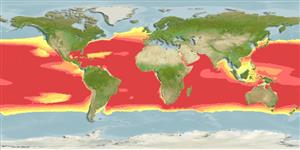Environment: milieu / climate zone / distribuzione batimetrica / distribution range
Ecologia
marino batipelagico; oceanodromo (Ref. 51243); distribuzione batimetrica 50 - 1000 m (Ref. 58302), usually 100 - 400 m (Ref. 47377). Deep-water
Atlantic, Indian and Pacific: in central water areas.
Size / Peso / Age
Maturità: Lm ? range ? - ? cm
Max length : 18.5 cm SL maschio/sesso non determinato; (Ref. 4058)
Short description
Chiavi di identificazione | Morfologia | Morfometria
Spine dorsali (totale) : 0; Raggi dorsali molli (totale) : 11 - 13; Spine anali: 0; Raggi anali molli: 26 - 30. Color in alcohol, dark brown over body and fins (Ref. 4058). Well preserved specimens with a brassy-green iridescent layer along flanks, beneath eye and on cheeks (Ref. 4058).
Body shape (shape guide): elongated.
Oceanic and mesopelagic (Ref. 7300, 58302). Feeds on fish and sepia by preferring the latter (Ref. 47377).
Life cycle and mating behavior
Maturità | Riproduzione | Deposizione | Uova | Fecundity | Larve
Johnson, R.K., 1986. Evermannellidae. p. 278-280. In M.M. Smith and P.C. Heemstra (eds.) Smiths' sea fishes. Springer-Verlag, Berlin. (Ref. 4058)
IUCN Red List Status (Ref. 130435: Version 2025-1)
Threat to humans
Harmless
Human uses
Pesca: di nessun interesse
Strumenti
Special reports
Download XML
Fonti Internet
Estimates based on models
Preferred temperature (Fonte Biblio.
123201): 10.3 - 23, mean 15.3 °C (based on 756 cells).
Phylogenetic diversity index (Fonte Biblio.
82804): PD
50 = 0.7539 [Uniqueness, from 0.5 = low to 2.0 = high].
Bayesian length-weight: a=0.00427 (0.00160 - 0.01136), b=3.12 (2.89 - 3.35), in cm total length, based on LWR estimates for this (Sub)family-body shape (Ref.
93245).
Trophic level (Fonte Biblio.
69278): 4.4 ±0.57 se; based on food items.
Fishing Vulnerability (Ref.
59153): Low vulnerability (13 of 100).
🛈
